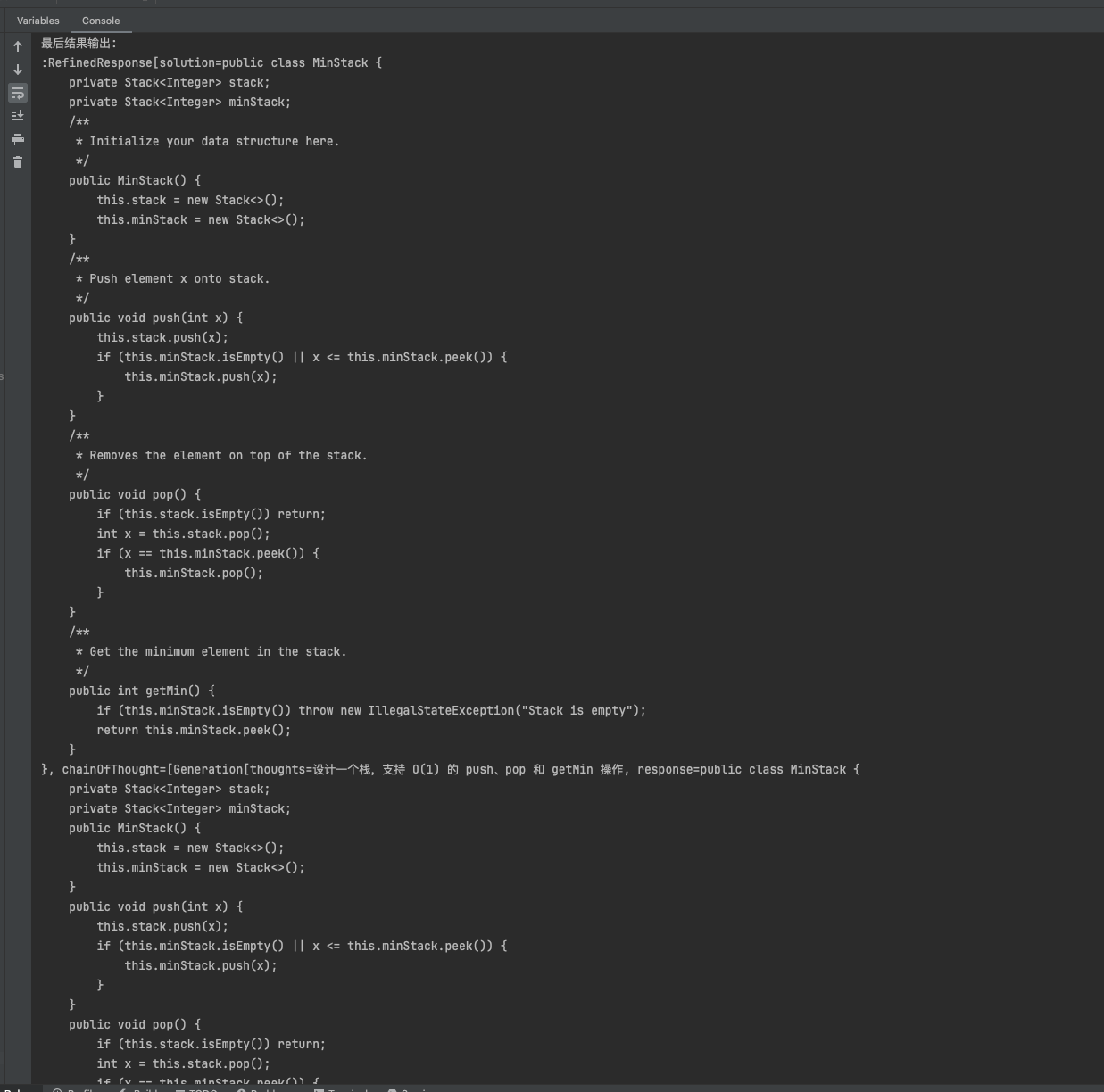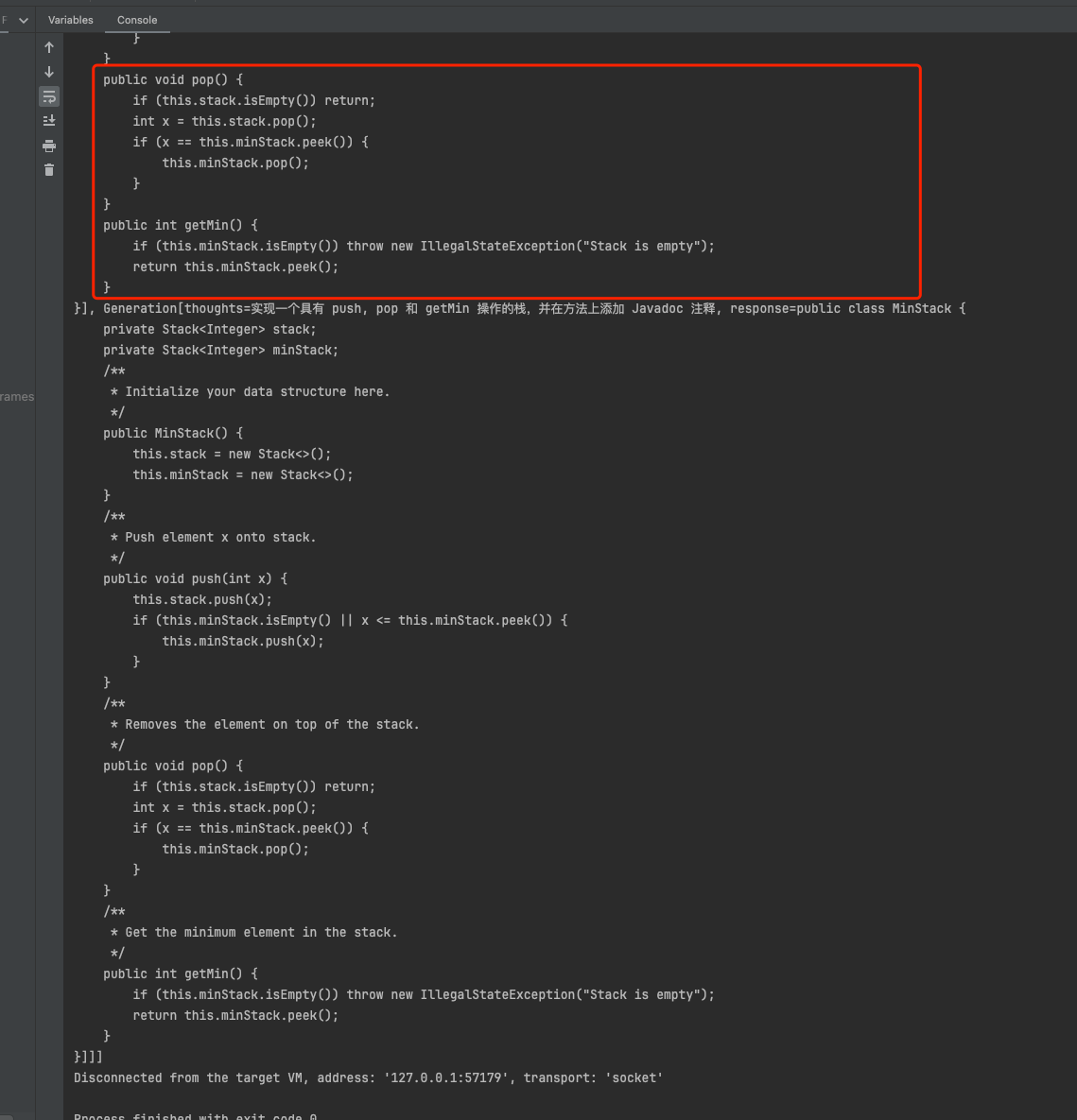
1. 评估优化工作流图
- 上面一张图选自langGraph
- 下面一张选自SpingAI


2.适用场景
3.代码实现流程图

4. 代码部分
4.1 启动部分
package com.coderpwh;
import com.coderpwh.work.EvaluatorOptimizer;
import org.springframework.ai.chat.client.ChatClient;
import org.springframework.boot.CommandLineRunner;
import org.springframework.boot.SpringApplication;
import org.springframework.boot.autoconfigure.SpringBootApplication;
import org.springframework.context.annotation.Bean;
@SpringBootApplication
public class Application {
public static void main(String[] args) {
SpringApplication.run(Application.class, args);
}
@Bean
public CommandLineRunner commandLineRunner(ChatClient.Builder chatClientBuilder) {
var chatClient = chatClientBuilder.build();
return args -> {
EvaluatorOptimizer.RefinedResponse refinedResponse = new EvaluatorOptimizer(chatClient)
.loop("""
<user input>
Implement a Stack in Java with:
1. push(x)
2. pop()
3. getMin()
All operations should be O(1).
All inner fields should be private and when used should be prefixed with 'this.'.
</user input>
""");
System.out.println("最后结果输出:\n:" + refinedResponse);
};
}
}
4.2 生成器部分(generate)
4.2.1 生成器提示词
public static final String DEFAULT_GENERATOR_PROMPT = """
你的目标是根据输入完成任务。如果有来自你先前生成内容的反馈,你应当参考这些反馈来优化你的解决方案。
重要:你的回复必须是**一行**有效的 JSON,**不能包含换行符**,除非是通过 \\n 显式转义的。
以下是你必须遵循的格式,包括所有引号和大括号:
{"thoughts":"简要描述你的思路","response":"public class Example {\\n // 代码写在这里\\n}"}
response 字段的规则如下:
1. 所有换行符必须使用 \\n
2. 所有引号必须使用 \\"
3. 所有反斜杠必须写成双反斜杠:\\\\
4. **禁止**实际换行或格式化 - 所有内容必须在同一行
5. 禁止使用制表符或特殊字符
6. Java 代码必须是完整的,并正确进行转义
格式示例(请严格模仿):
{"thoughts":"实现计数器","response":"public class Counter {\\n private int count;\\n public Counter() {\\n count = 0;\\n }\\n public void increment() {\\n count++;\\n }\\n}"}
请**严格**遵循该格式 - 你的输出必须是**一行有效 JSON 字符串**。
""";
4.2.2 generate部分代码
- Generation 实体
- thoughts 意图
- response 结果
private Generation generate(String task, String context) {
Generation generationResponse = chatClient.prompt()
.user(u -> u.text("{prompt}\\n{context}\\nTask: {task}")
.param("prompt", this.generatorPrompt)
.param("context", context)
.param("task", task))
.call()
.entity(Generation.class);
System.out.println(String.format("\n=== 生成输出 ===\n意图: %s\n\n返回结果:\n %s\n", generationResponse.thoughts(), generationResponse.response()));
return generationResponse;
}
public static record Generation(String thoughts, String response) {
}
4.3 评估部分
4.3.1 评估部分提示词
public static final String DEFAULT_EVALUATOR_PROMPT = """
请对以下代码实现进行评估,考虑以下方面:正确性、时间复杂度和最佳实践。
请确保代码包含适当的 Javadoc 文档。
请使用**完全相同格式的 JSON 字符串,且仅占用一行**进行回复:
{"evaluation":"PASS、NEEDS_IMPROVEMENT 或 FAIL 之一", "feedback":"在此填写你的反馈"}
evaluation 字段的取值只能是以下三种之一:"PASS"、"NEEDS_IMPROVEMENT" 或 "FAIL"
仅当所有评估标准都完全达标、无需改进时,才使用 "PASS"
""";
4.3.2 evaluate 代码部分
- EvaluationResponse 实体
- Evaluation 枚举(PASS, NEEDS_IMPROVEMENT, FAIL)
- feedback 反馈
private EvaluationResponse evaluate(String content, String task) {
EvaluationResponse evaluationResponse = chatClient.prompt()
.user(u -> u.text("{prompt}\nOriginal task: {task}\nContent to evaluate: {content}")
.param("prompt", this.evaluatorPrompt)
.param("task", task)
.param("content", content))
.call()
.entity(EvaluationResponse.class);
System.out.println(String.format("\n=== 评估输出:===\n评估: %s\n\n反馈: %s\n", evaluationResponse.evaluation(), evaluationResponse.feedback()));
return evaluationResponse;
}
public static record EvaluationResponse(Evaluation evaluation, String feedback) {
public enum Evaluation {
PASS, NEEDS_IMPROVEMENT, FAIL
}
}
4.4环形调用
- 依照上面的代码实现流程图,包含如下部分
- 生成部分
- 评估
- 对评估结果进行判断
- 评估符合返回即可,否则继续递归调用
public RefinedResponse loop(String task, String context, List<String> memory, List<Generation> chainOfThought) {
Generation generation = generate(task, context);
memory.add(generation.response());
chainOfThought.add(generation);
EvaluationResponse evaluationResponse = evaluate(generation.response(), task);
if (evaluationResponse.evaluation().equals(EvaluationResponse.Evaluation.PASS)) {
return new RefinedResponse(generation.response(), chainOfThought);
}
StringBuilder newContext = new StringBuilder();
newContext.append("Previous attempts:");
for (String m : memory) {
newContext.append("\n- ").append(m);
}
newContext.append("\\nFeedback:").append(evaluationResponse.feedback());
return loop(task, newContext.toString(), memory, chainOfThought);
}
4.5 完整代码部分
package com.coderpwh.work;
import org.springframework.ai.chat.client.ChatClient;
import org.springframework.util.Assert;
import java.util.ArrayList;
import java.util.List;
@SuppressWarnings("null")
public class EvaluatorOptimizer {
public static final String DEFAULT_GENERATOR_PROMPT = """
你的目标是根据输入完成任务。如果有来自你先前生成内容的反馈,你应当参考这些反馈来优化你的解决方案。
重要:你的回复必须是**一行**有效的 JSON,**不能包含换行符**,除非是通过 \\n 显式转义的。
以下是你必须遵循的格式,包括所有引号和大括号:
{"thoughts":"简要描述你的思路","response":"public class Example {\\n // 代码写在这里\\n}"}
response 字段的规则如下:
1. 所有换行符必须使用 \\n
2. 所有引号必须使用 \\"
3. 所有反斜杠必须写成双反斜杠:\\\\
4. **禁止**实际换行或格式化 - 所有内容必须在同一行
5. 禁止使用制表符或特殊字符
6. Java 代码必须是完整的,并正确进行转义
格式示例(请严格模仿):
{"thoughts":"实现计数器","response":"public class Counter {\\n private int count;\\n public Counter() {\\n count = 0;\\n }\\n public void increment() {\\n count++;\\n }\\n}"}
请**严格**遵循该格式 - 你的输出必须是**一行有效 JSON 字符串**。
""";
public static final String DEFAULT_EVALUATOR_PROMPT = """
请对以下代码实现进行评估,考虑以下方面:正确性、时间复杂度和最佳实践。
请确保代码包含适当的 Javadoc 文档。
请使用**完全相同格式的 JSON 字符串,且仅占用一行**进行回复:
{"evaluation":"PASS、NEEDS_IMPROVEMENT 或 FAIL 之一", "feedback":"在此填写你的反馈"}
evaluation 字段的取值只能是以下三种之一:"PASS"、"NEEDS_IMPROVEMENT" 或 "FAIL"
仅当所有评估标准都完全达标、无需改进时,才使用 "PASS"
""";
public static record Generation(String thoughts, String response) {
}
public static record EvaluationResponse(Evaluation evaluation, String feedback) {
public enum Evaluation {
PASS, NEEDS_IMPROVEMENT, FAIL
}
}
public static record RefinedResponse(String solution, List<Generation> chainOfThought) {
}
private final ChatClient chatClient;
private final String generatorPrompt;
private final String evaluatorPrompt;
public EvaluatorOptimizer(ChatClient chatClient) {
this(chatClient, DEFAULT_GENERATOR_PROMPT, DEFAULT_EVALUATOR_PROMPT);
}
public EvaluatorOptimizer(ChatClient chatClient, String generatorPrompt, String evaluatorPrompt) {
Assert.notNull(chatClient, "ChatClient must not be null");
Assert.hasText(generatorPrompt, "Generator prompt must not be empty");
Assert.hasText(evaluatorPrompt, "Evaluator prompt must not be empty");
this.chatClient = chatClient;
this.generatorPrompt = generatorPrompt;
this.evaluatorPrompt = evaluatorPrompt;
}
public RefinedResponse loop(String task) {
List<String> memory = new ArrayList<>();
List<Generation> chainOfThought = new ArrayList<>();
return loop(task, "", memory, chainOfThought);
}
public RefinedResponse loop(String task, String context, List<String> memory, List<Generation> chainOfThought) {
Generation generation = generate(task, context);
memory.add(generation.response());
chainOfThought.add(generation);
EvaluationResponse evaluationResponse = evaluate(generation.response(), task);
if (evaluationResponse.evaluation().equals(EvaluationResponse.Evaluation.PASS)) {
return new RefinedResponse(generation.response(), chainOfThought);
}
StringBuilder newContext = new StringBuilder();
newContext.append("Previous attempts:");
for (String m : memory) {
newContext.append("\n- ").append(m);
}
newContext.append("\\nFeedback:").append(evaluationResponse.feedback());
return loop(task, newContext.toString(), memory, chainOfThought);
}
private Generation generate(String task, String context) {
Generation generationResponse = chatClient.prompt()
.user(u -> u.text("{prompt}\\n{context}\\nTask: {task}")
.param("prompt", this.generatorPrompt)
.param("context", context)
.param("task", task))
.call()
.entity(Generation.class);
System.out.println(String.format("\n=== 生成输出 ===\n意图: %s\n\n返回结果:\n %s\n", generationResponse.thoughts(), generationResponse.response()));
return generationResponse;
}
private EvaluationResponse evaluate(String content, String task) {
EvaluationResponse evaluationResponse = chatClient.prompt()
.user(u -> u.text("{prompt}\nOriginal task: {task}\nContent to evaluate: {content}")
.param("prompt", this.evaluatorPrompt)
.param("task", task)
.param("content", content))
.call()
.entity(EvaluationResponse.class);
System.out.println(String.format("\n=== 评估输出:===\n评估: %s\n\n反馈: %s\n", evaluationResponse.evaluation(), evaluationResponse.feedback()));
return evaluationResponse;
}
}
5.实例













